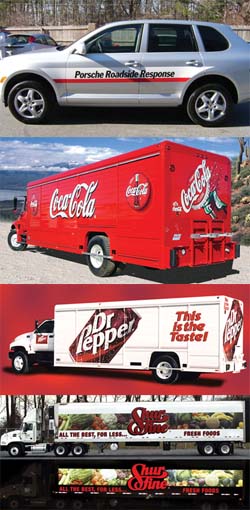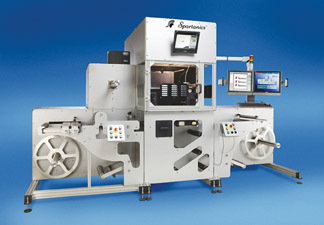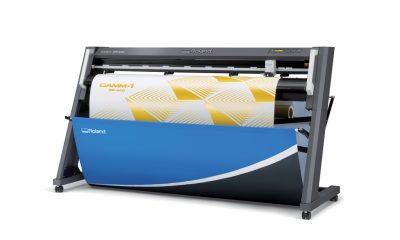Graphics Printing
Published
18 years agoon

"If you don’t like change, you’re going to like irrelevance even less!" These famous words were spoken by US Army General Eric Shinseki, and they’re the inspiration behind the business philosophy of Knoxville, TN-based American Screen Art, a graphics-printing shop that has served the fleet- and beverage-graphics industries for more than 50 years. In that time, the company has undergone numerous transitions that have taught it to embrace new technologies and focus on customer satisfaction.
A history of transformation
"If you don’t like change, you’re going to like irrelevance even less!" These famous words were spoken by US Army General Eric Shinseki, and they’re the inspiration behind the business philosophy of Knoxville, TN-based American Screen Art, a graphics-printing shop that has served the fleet- and beverage-graphics industries for more than 50 years. In that time, the company has undergone numerous transitions that have taught it to embrace new technologies and focus on customer satisfaction.
A history of transformation
John Bricketo, John Anderson, Mack Williams, and Dave Collins founded the company, then known as Screen Art, in 1955. The business occupied a 30,000-sq-ft facility and consisted of a handful of employees, a few one-color screen-printing presses, and a couple of diecutting presses. The shop focused on printing fleet graphics.
Engraph, a company that produced corrugated products for the beverage industry, acquired Screen Art in the mid-1960s. Engraph used lithography, roto gravure, and offset technologies to print graphics, and it purchased Screen Art to serve as its screen-printing arm.
Two decades later, Engraph sold Screen Art to Sonoco, another printing company that served the corrugated-packing industry. Sonoco formed Ariston, a sister division of Screen Art, in New Jersey. Ariston handled most of the fleet-graphics jobs, while Screen Art was responsible for the beverage-related print work. Screen Art retained several major fleet-graphics accounts for its beverage industry customers, including Coke, Pepsi, Dr. Pepper, 7-Up, as well as for Averitt Express.
In 1997, Sonoco sold Screen Art and Ariston to City Corp. Venture Capital and Graphic Design Technology. Five years later, the pair of companies put Screen Art and Ariston on the market. Ariston was liquidated completely, and Equity South acquired Screen Art. Within a few weeks, Screen Art was re-established as American Screen Art with the same management team and employees that started with the company in 1955 and remained loyal throughout its many transitions of ownership.
Taking charge of change
American Screen Art realized early on that in order to survive a changing marketplace, it would have to be willing to accept inevitable shifts in the industries it served and adopt new technologies and processes to maintain a competitive foothold. When the company first opened, it was outfitted with an ample amount of equipment to support the print jobs that it was producing for fleet and beverage applications. However, the company’s growing client base brought with it the need to add equipment and processes to support the increasing order volume. American Screen Art recognized that to continue satisfying its customers, it needed equipment that also would support new graphics applications and materials.
In 1985, American Screen Art moved to a facility three times the size of its original plant. Its focus remained on the fleet and beverage markets, and print jobs at the time consisted of vehicle graphics (Figure 1), beverage-vending-machine graphics, replacement decals, and fountain graphics. Business in these markets continued to boom, and in 1996, American Screen Art purchased its first Tekind multicolor inline screen-printing press to meet the demand for print jobs in the beverage market and to support the company’s switch from solvent-based ink formulations to UV-curable inks. The company added its second and third multicolor inline presses, manufactured by Sias, in 1997 and 1999.
American Screen Art’s fleet-graphics business continued to experience significant growth. One of the company’s sales representatives called upon McDonald’s, whose marketing departmentex- pressed an interest in affixing images of McDonald’s products on its fleet of trucks. American Screen Art produced prototypes and impressed McDonald’s marketing team with its capability to print four-color-process graphics for the vehicles. With the McDonald’s account, American Screen Art became the first screen-printing operation to implement a national, full-coverage, four-color-process fleet program.
Dennis Alexander, American Screen Art’s COO, says this type of printing is no easy feat. "It’s essentially a combination of good screen-printing processes," he explains. "You have to do prepress work, make good color separations, and be able to print by the numbers. We have to match densities, dot gain, registration, and put it all together. And we have a quality process that allows us to do that."
The screen-printing side
Today, American Screen Art is located in a 90,000-sq-ft facility (Figure 2) that houses 100 employees and various departments to support the solutions that the company offers its customers. It all begins in the company’s prepress department, which maintains a staff of eight. Here employees use Apple Macintosh G5 computers equipped with design programs such as Adobe Illustrator, Adobe Photoshop, and Quark XPress. The prepress area also is equipped with filmmaking devices and exposure units. The screenmaking staff produces screens in sizes ranging from 12 x 12 to 60 x 120 in. (305 x 305 to 1524 x 3048 mm) and maintains a huge inventory of completed screens (Figure 3).
The majority of American Screen Art’s jobs are produced in the screen-printing-production area (Figure 4) on any of its single-color presses or three multicolor inline presses. The company also has a collection of finishing equipment, including guillotine cutters, a laminator, CNC router, vinyl cutters, and steel-rule and thermal diecutting devices (Figure 5).
American Screen Art established a kitting and fulfillment-service program to meet customer demands in the beverage and P-O-S/P-O-P markets. In this area, employees pick, kit, collate, pack, and ship graphics to specific client locations.
The company’s devotion to its customers doesn’t end when finished products leave the shipping dock. For example, the company established a department to handle graphics-application and removal services to ensure that fleeted graphics are installed properly.
American Screen Art’s management realized that customers wanted turnkey services. They moved quickly to establish a team of applicators and put the new hires through a training system developed by 3M. American Screen Art requires its applicators to be insured and bonded, and they are fully responsible for product installation and/or removal. Today, American Screen Art’s team of 3M-certified applicators is located throughout the country.
Opportunities in digital printing
An increase in demand for valve decals and flavor strips for beverage equipment prompted American Screen Art to make an important addition to its operation: digital-printing technology. In 1996, the company purchased an HP Indigo E-Print, a plateless digital offset system, to complement its inline screen-printing equipment. The new technology presented a few challenges, but American Screen Art was able to reap rewards from its new purchase within six months after acquiring the machine.
"It offered the best balance between variable printing, flexibility of substrates, and durability in the size format that allowed us to offer our customers more flexibility, faster response times, and lower inventory exposure—all pretty radical thinking for the time," Alexander says. "It was a gamble that has paid off for our customers."
Alexander credits American Screen Art with being aggressive in adapting new technology early, especially when the company sees an opportunity to help its customers. Acquiring the Indigo was justified by the benefits it brought in producing graphic labels for beverage fountains. Fountain graphics continue to be the lion’s share of work performed on the HP press, but American Screen Art also has been able to use the printer for other projects, including in-house marketing collateral.
In 2003, American Screen Art made an investment in UV-inkjet technology with the purchase of a Leggett & Platt Virtu flatbed printer. Alexander says the company’s desire to minimize VOC emissions was a big part of its decision to buy a UV inkjet printer. He notes that using the Virtu has brought the shop’s emissions "well below what our local laws allow."
Alexander also says the Virtu’s hybrid configuration gives American Screen Art the flexibility to print both wide-web roll-to-roll or rigid sheet stock. This created an opportunity to enter markets that weren’t previously accessible. Retail graphics is one example. American Screen Art’s Indigo allowed the shop to handle the occasional retail-graphics job, but it wasn’t until the addition of the Virtu printer that the company was able to make such work a regular part of its product portfolio.
"We saw the impact that digital was having on the fleet and retail market, and we were looking for a way to leverage the available digital technology to the beverage market—not too different a thought process from what we employed when we purchased the HP Indigo years earlier," Alexander says. "In addition, our business mix was changing, with more emphasis on fleet and retail graphics. We have a long history of involvement with re-branding programs in both of those markets, having executed programs for many Fortune 500 companies in the consumer-products, service, and retail markets. We knew that to continue to grow in those markets, we would need the flexibility offered by a large-format digital press."
The company keeps its Virtu busy printing on everything from paper to metal. Common applications include indoor and outdoor wall murals and floor graphics, banners, window graphics, backlit sign faces, pole wraps, menu boards, and more on materials such styrene, Sintra, foam board, polycarbonate, wood, and textiles.
American Screen Art also uses its Virtu press to print various types of lenticular graphics for cold-drink vending machines and for retail applications (Figure 6). The company also produces reflective and backlit lenticular graphics for small illuminated boxes or wall applications 9 sq ft and larger.
The implementation of digital-printing technology has proven its value to American Screen Art. Even though the shop continues to produce a majority (85-90%) of its jobs on screen-printing equipment, the digital presses allow the company to fulfill short-run print jobs and prototype pieces for customers. Alexander says the screen and digital technologies definitely complement each other.
Investment in employees
American Screen Art prides itself on having a staff of loyal employees who have remained with the company since its inception, and the management team takes a great interest in training its staff to meet the work standards established for each position. Training begins with a screening of basic skills, such as language, math, computers, and color recognition. The company then sends its employees to formal training classes that are led by the shop’s operations staff. Each trainee is then assigned to a skilled employee to learn the actual hands-on, nitty-gritty details for each job. Employees also are cross-trained in order to meet demands for additional help in specific departments or large jobs where extra help is needed.
American Screen Art believes in involving its staff in issues of environmental concern. The first major "green" move American Screen Art made was to switch from solvent-based to UV inks. The company also stresses the importance of using biodegradable cleaning agents and recycling wherever possible. Alexander says the shop recycles most of the materials it uses, including paper, corrugated products, and wooden pallets.
Notable achievements
American Screen Art is a company that eagerly embraces innovation and change. As such, it boasts many firsts. The company says it was among the first national large-format screen-printing operations to use multicolor-inline-press technology and the first to offer its customers a higher level of service through inventory programs, just-in-time delivery, design, and turnkey international program management. It also was one of the first screen printers to invest in small- and large-format digital-printing technology, offering full-color, short-run capabilities.
American Screen Art’s ambition to implement new technologies, take on challenging applications, and develop innovative products has earned it recognition throughout the industry and accolades in various categories of competition. For example, the company was recognized in the 2005 HP Indigo Ribbon Awards for a product that it entered in the specialty printing P-O-P/P-O-S category. The company also has received quite a bit of attention for Perma-Bright, a specially designed diffuser laminate it developed for backlit applications, and Tough Cal and Tough Hide products, which provide extra-durable graphics for soft-drink vending machines.
On the horizon
American Screen Art maintains its focus on the three major markets in which it has cultivated solid relationships: beverage, fleet, and retail graphics. Some of the company’s goals include striking a better balance in those areas, maintaining growth in the beverage market, continuing to develop in the fleet market, and expanding in the retail market. American Screen Art also provides OEM products for vending equipment, confectionery equipment, and decals for the electronics industry. The company plans to explore additional OEM opportunities in the near future.
American Screen Art’s production capabilities allow the company to fulfill a plethora of job orders of various sizes, quantities, and numbers of colors in the beverage, fleet, and retail markets. However, to support its goals for continued growth and market expansion, the company intends to build up its digital-imaging department with the addition of more printing and finishing equipment over the course of the next year. American Screen Art has significantly increased its sales force over the past year to capitalize on its production capabilities. In addition, the company has been pursuing a strategy of building its sales through acquisitions of complementary businesses.
Alexander says that American Screen Art would like to expand the digital side of the business to the point that digital printing accounts for 1⁄3 of the shop’s business. The management team has yet to decide whether those digital additions will include flatbed, roll-fed, or hybrid printers.
"Statistics show that screen printing, at least on the graphics side, is flat as far as growth—maybe even slightly declining. I still see that it has a future, but the growth from a graphics provider is on the digital side," Alexander says. "So we try to use digital printing to take care of short runs and give us an opportunity to produce prototypes when it’s not cost-effective to do so with screen-printing technology."
Alexander isn’t sure whether American Screen Art will ever be an all-digital shop. He believes having screen and ink-jet technologies in house offers a nice balance. But regardless of what direction the company takes, Alexander says American Screen Art will continue to look for and embrace changes that benefit the company and its customers.

Subscribe

Magazine
Get the most important news
and business ideas from Screenprinting Magazine.
Most Popular
-

 Case Studies2 months ago
Case Studies2 months agoHigh-Density Inks Help Specialty Printing Take Center Stage
-

 Art, Ad, or Alchemy2 months ago
Art, Ad, or Alchemy2 months agoF&I Printing Is Everywhere!
-

 Andy MacDougall2 months ago
Andy MacDougall2 months agoFunctional and Industrial Printing is EVERYWHERE!
-

 Columns3 weeks ago
Columns3 weeks ago8 Marketing Mistakes Not to Make When Promoting Your Screen Printing Services Online
-

 Editor's Note3 weeks ago
Editor's Note3 weeks agoLivin’ the High Life
-

 Marshall Atkinson3 weeks ago
Marshall Atkinson3 weeks agoHow to Create a Winning Culture in Your Screen-Printing Business
-

 Thomas Trimingham2 months ago
Thomas Trimingham2 months ago“Magic” Marketing for Screen Printing Shops
-

 News & Trends2 months ago
News & Trends2 months agoWhat Are ZALPHAS and How Can You Serve Them in Your Print Business?






